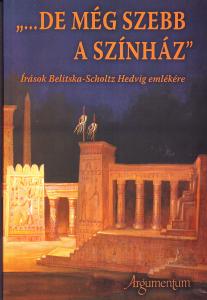
“…but even more beautiful is the theatre”
„…de még szebb a színház”
(“…but even more beautiful is the theatre”)
Writings in honour of Hedvig Belitska-Scholtz
Edited by Olga Somorjai
Contributing editors: Edit Rajnai, Nóra Wellmann
Bibliography of the works of Hedvig Belitska-Scholtz compiled by Edit Rajnai
Argumentum Publishing House, Budapest, 2010, 284+28 pages
ISBN 978 963 446 557 7
Hedvig Belitska-Scholtz was one of those free spirits whose greatness is not in their doctorates, but in the atmosphere that their enchanting personality conveys. In 1969, with a degree in German art history and later Italian, she began working in the scenography collection of the Hungarian Theatre Institute. From 1980 until the end of her life, she was the head of the Theatre History Collection of the National Széchényi Library. With an international outlook and orientation, she set to work with ambitious ideas, preserving existing values but with an innovative drive and ambitious plans.
With the work on the complex bibliography of German drama in Pest-Buda, she has started a research that will allow the complete mapping of Hungarian drama to be continued. As an art historian and theatre historian, she was interested in theatrical spectacle from the very beginning. After collecting Baroque, Classicist and Romantic stage sets and processing 19th century theatre graphics, she began researching the National Theatre's set and costume inventories. Her great dream was to present the treasures of the scenic collection in the Kunsthalle, but her plan was only realised with an exhibition of Gusztáv Oláh's oeuvre in the Ernst Museum. Like her polymath predecessor, the book collector and patron Miklós Jankovich, on whose oeuvre she edited a volume of studies, she wanted to enrich her collection. The collection included theatre libraries and archives, the works of set and costume designers of epochal importance, stage sets, photographs and bequests from all over the world. She has sketched out the blueprint for a topography of the theatre, but for a future generation.
Hedvig, a homo theatralicus left us. (Or did she not?) The theatre fascinated her, she loved it, admired it, but was critical of it, too. The imprint of her concept of collecting and theatre history is left permanently on the exemplary collection of the library's Theatre History Collection. Her life's work, her thoughts, her spirit and the fragmented title of this memorial volume are made clear and complete by the above: 'this collection is wonderful...'
Shopping
Our publications are available in our bookshop, or can be ordered from the Publications Department of the NSZL using the contact details below: Főigazgatói Kabinet kiadványtára, Országos Széchényi Könyvtár, 1276 Budapest P.O. box 1205., phone: 06-1-23-23-506, e-mail: kiadvanytar@oszk.hu.




